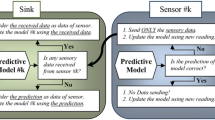Abstract
Currently one of the main problem for wireless networks is the medium access control. Hence, the number of data transmissions in wireless sensor networks should be optimized to support more applications and a higher diversity of sensed parameters. In addition, minimizing energy consumption of sensor nodes constitutes one of the main ways to prolong network lifetime. One way to achieve this objective is the exploitation of data prediction technique. This paper presents an innovative idea improving the adaptive dual prediction algorithm without recourse to the data history table to update the model parameters when it drifts. The idea is to exploit immediately the new model parameters performed from the stored ones corresponding to the models used previously during the past prediction phases and eliminated when the threshold imposed by the user exceeded. We carried out simulations using real data of meteorological parameters. We show that our approach achieves up to 99% communication reduction with no significant loss in accuracy.





Similar content being viewed by others
References
Samarah, S. (2015). A data predication model for integrating wireless sensor networks and cloud computing. Procedia Computer Science, 52, 1141–1146. https://doi.org/10.1016/j.procs.2015.05.148.
Raza, U., Camerra, A., Murphy, A. L., Palpanas, T., & Picco, G. P. (2015). Practical data prediction for real-world wireless sensor networks. IEEE Transactions on Knowledge and Data Engineering, 27(8), 2231–2244. https://doi.org/10.1109/TKDE.2015.2411594.
Hyndman, R. J., & Athanasopoulos, G. (2017). Forecasting: Principles and practice. http://otexts.com/fpp/2/5/. Accessed 3 Nov 2017.
Wu, M., Tan, L., & Xiong, N. (2016). Data prediction, compression, and recovery in clustered wireless sensor networks for environmental monitoring applications. Information Sciences, 329, 800–818. https://doi.org/10.1016/j.ins.2015.10.004.
Brunelli, D., Dondi, D., Bertacchini, A., Larcher, L., Pavan, P., & Benin, L. (2009). Photovoltaic scavenging systems: Modeling and optimization. Microelectronics Journal, 40(9), 1337–1344. https://doi.org/10.1016/j.mejo.2008.08.013.
Caione, C., Brunelli, D., & Benini, L. (2010). Compressive sensing optimization over ZigBee networks. In 2010 International symposium on industrial embedded system (SIES), pp. 36–44.
Aderohunmu, F. A., Paci, G., Brunelli, D., Deng, J. D., & Benini, L. (2013). Prolonging the lifetime of wireless sensor networks using light-weight forecasting algorithms. In 2013 IEEE eighth international conference on intelligent sensors, sensor networks and information processing, pp. 461–466.
Aderohunmu, F. A., Paci, G., Brunelli, D., Deng, J. D., Benini, L., & Purvis, M. (2013). An application-specific forecasting algorithm for extending WSN lifetime. In 2013 IEEE international conference on distributed computing in sensor systems, pp. 374–381.
Dias, G. M., Bellalta, B., & Oechsner, S. (2016). A survey about prediction-based data reduction in wireless sensor networks. ACM Computing Surveys, 49, 35. https://doi.org/10.1145/2996356.
Jiang, H., Jin, S., & Wang, C. (2011). Prediction or not? An energy-efficient framework for clustering-based data collection in wireless sensor networks. IEEE Transactions on Parallel and Distributed Systems, 22(6), 1064–1071. https://doi.org/10.1109/TPDS.2010.174.
Langendoen, K., & Meier, A. (2010). Analyzing MAC protocols for low data-rate applications. ACM Transactions on Sensor Networks, 7(1), 34. https://doi.org/10.1145/1806895.1806905.
Dias, G. M., Bellalta, B., & Oechsner, S. (2017). The impact of dual prediction schemes on the reduction of the number of transmissions in sensor networks. Computer Communications, 112(1), 58–72. https://doi.org/10.1016/j.comcom.2017.08.002.
Souza, L., Pazzi, R. W., & Nakamura, E. F. (2015). A prediction-based clustering algorithm for tracking targets in quantized areas for wireless sensor networks. Wireless Networks, 21(7), 2263–2278. https://doi.org/10.1007/s11276-015-0914-3.
Nazaktabar, H., Badie, K., & Ahmadabadi, M. N. (2017). RLSP: A signal prediction algorithm for energy conservation in wireless sensor networks. Wireless Networks, 23, 919–933. https://doi.org/10.1007/s11276-016-1200-8.
McCorrie, D. J., Gaura, E., Burnham, K., Poole, N., & Hazelden, R. (2015). Predictive data reduction in wireless sensor networks using selective filtering for engine monitoring. In Wireless sensor and mobile ad-hoc networks: Vehicular and space applications, Springer New York, NY, pp. 129-148. https://doi.org/10.1007/978-1-4939-2468-4_6.
Liu, C., Wu, K., & Tsao, M. (2005). Energy efficient information collection with the ARIMA model in wireless sensor networks. In 2005 IEEE global telecommunications conference, Vol. 5, pp. 2470–2474.
Santini S., & Romer, K. (2006). An adaptive strategy for quality-based data reduction in wireless sensor networks. In Third international conference on networked sensing systems, pp. 29–36.
Tulone D., & Madden, S. (2006). PAQ: Time series forecasting for approximate query answering in sensor networks. In Wireless sensor networks, Vol. 3868, Springer, pp. 21–37. https://doi.org/10.1007/11669463_5.
Clark, B. N., Colbourn, C. J., & Johnson, D. S. (1990). Unit disk graphs. Discrete Mathematics, 86(13), 165–177. https://doi.org/10.1016/0012-365X(90)90358-O.
Karp, B., & Kung, H. T. (2000). GPSR: Greedy perimeter stateless routing for wireless networks. In Sixth annual international conference on mobile computing and networking (MobiCom00), pp. 243–254.
Wang, F., & Liu, J. (2011). Networked wireless sensor data collection: Issues, challenges, and approaches. IEEE Communications Surveys & Tutorials, 13(4), 673–687. https://doi.org/10.1109/SURV.2011.060710.00066.
Le Borgne, Y. A., Santini, S., & Bontempi, G. (2007). Adaptive model selection for time series prediction in wireless sensor networks. Signal Process, 87(12), 3010–3020. https://doi.org/10.1016/j.sigpro.2007.05.015.
Li, G., & Wang, Y. (2013). Automatic ARIMA modeling-based data aggregation scheme in wireless sensor networks. EURASIP Journal on Wireless Communications and Networking, 2013(85), 1–13. https://doi.org/10.1186/1687-1499-2013-85.
Mohanty, S. P. (2015). Nanoelectronic mixed-signal system design. McGraw-Hill. ISBN: 978-0071825719.
Rajaram, M. L. (2015). Comparative analysis and implementation of high data rate wireless sensor network simulation frameworks. Masters Thesis, Department of Engineering Technology, University of North Texas.
Polastre, J., Szewczyk R., & Culler, D. (2005). Telos: Enabling ultra-low power wireless research. In Fourth international symposium on information processing in sensor networks, pp. 364–369.
Author information
Authors and Affiliations
Corresponding author
Additional information
Publisher's Note
Springer Nature remains neutral with regard to jurisdictional claims in published maps and institutional affiliations.
Rights and permissions
About this article
Cite this article
Liazid, H., Lehsaini, M. & Liazid, A. An improved adaptive dual prediction scheme for reducing data transmission in wireless sensor networks. Wireless Netw 25, 3545–3555 (2019). https://doi.org/10.1007/s11276-019-01950-7
Published:
Issue Date:
DOI: https://doi.org/10.1007/s11276-019-01950-7




